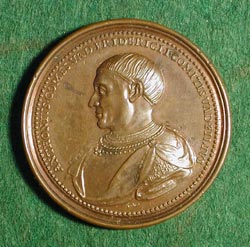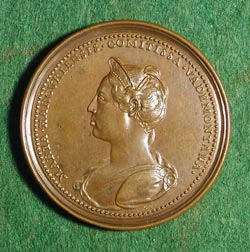

|
ANTOINE, COUNT OF VAUDEMONT AND MARIE D'HARCOURT ST URBAIN, Ferdinand de: Lorraine, ca.1727, Bronze, 45 mm Antoine I de Lorraine (1401-1458), count of Vaudemont, was the nephew
of Charles II, Duke of Lorraine, and on the death of Charles, as the
heir-male, he claimed the inheritance to the duchy. However, Rene, Duke of
Anjou, in a marriage treaty with Isabella, elder daughter of Charles II, was
to be heir to the duchy of Lorraine at the death of Charles, which occurred
in 1431. A battle ensued and, with Burgundian help, Antoine de Vaudemont
defeated Rene at Bulgneville. The duchess Isabella effected a truce with
Antoine de Vaudemont, but Rene remained a prisoner of the Burgundians until
1432, when he recovered his liberty on parole by agreeing to yield up as
hostages his two sons, John and Louis of Anjou. Rene became Rene I, Duke of
Lorraine, in 1434. LINK to History of Lorraine (from Proceedings of the Friesian School. Edited by Kelley L. Ross, Ph.D.) |
|